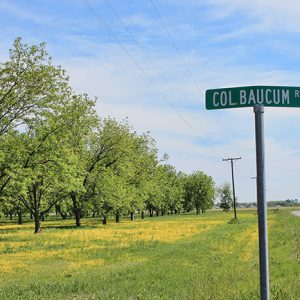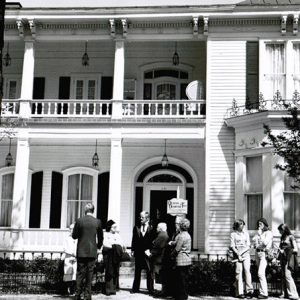calsfoundation@cals.org
George Franklin Baucum (1837–1905)
George F. Baucum was a Confederate officer and a Little Rock (Pulaski County) businessman. He served in many major battles of the Civil War’s western theater, including at Murfreesboro in Tennessee and Chickamauga and Atlanta in Georgia. After the war, he became a prominent grocer, cotton broker, and banker who owned plantations in central Arkansas.
George Franklin Baucum was born on February 1, 1837, in St. Charles, Missouri. He was the son of Daniel Baucum and Kathryn Baucum, both of whom were natives of Mississippi. The family moved to Memphis, Tennessee, in 1851. Two years later, the Baucums settled in Searcy (White County).
At the outbreak of the Civil War, Baucum was working as a grocer in Searcy. He joined the Eighth Arkansas Infantry as a lieutenant in 1861. Following the reorganization of the Army of Mississippi (what became the Army of Tennessee) after the Battle of Shiloh, Baucum was promoted. By the time of the October 8, 1862, Battle of Perryville in Kentucky, he was a lieutenant colonel. At the Battle of Murfreesboro, he took charge of his regiment following the wounding of its commanding colonel, John H. Kelly. Baucum saw vicious fighting in a cornfield and cotton field at the battle, where his regiment suffered many casualties. He lost a horse and was in poor condition.
In 1863, Baucum took part in the Tullahoma Campaign and the bloody Battle of Chickamauga, where he was wounded in the foot while trying to capture enemy artillery. His injury, however, did not prevent him from fighting two months later at Missionary Ridge in Tennessee and Ringgold Gap in Georgia. In January 1864, Baucum was among the officers who signed Patrick Cleburne’s controversial proposal to arm slaves so that they could fight for the Confederacy. The proposal was rejected by Cleburne’s superiors.
Baucum took part in the battles for Atlanta. In late May 1864, he won praise from Cleburne for his conduct at New Hope Church in Georgia. Cleburne said Baucum fought with “irresistible impetuosity.” The army’s commander, Joseph E. Johnston, agreed, saying Baucum’s “little body [of Arkansans] met the foremost of the Federal troops…and preserved the Texans from an attack in flank which must have been fatal.” At the July 22, 1864, Battle of Atlanta, Baucum was shot in the face, with the bullet lodging in his collarbone. He returned to Arkansas to recover, but the wound kept him from active duty. He served as a recruiting agent until the end of the war and surrendered in Grenada, Mississippi, in June 1865.
After the war, Baucum returned to Searcy. In 1876, he moved to Little Rock, where he worked as a wholesale grocer. That year, he bought what is now known as the White-Baucum House, which was originally owned by Robert J. T. White. Baucum also owned plantations in Scott (Pulaski and Lonoke counties) and Saline County. Colonel Baucum Road, which runs through Scott, is named after him. Baucum’s plantation in Scott became the site of Baucum Nursery, opened in 1936, one of the largest hardwood nurseries in the southern United States.
Baucum was married twice. His first wife was Glovenia Critz, the daughter of a Confederate officer. She had one child with Baucum, a daughter named Katherine. Glovenia died in 1874. On December 28 of that year, Baucum married Rebecca Darrington McRae, sister of General Dandridge McRae, in West Point in White County. They had two children: Margaret and Georgia.
After Reconstruction, Baucum served as president of the Bank of Little Rock. In the 1880s, he co-founded the Arkansas Board of Trade, where he served as a vice president. He was also president of the Little Rock and St. Louis Railroad. He died on July 29, 1905, and is buried in Oakland Cemetery in Little Rock. His wife died in 1922.
In February 1980, the White-Baucum House, located on Izard Street in Little Rock and known for its Italianate architecture, was placed on the National Register of Historic Places.
The house eventually fell into disrepair. In 2010, an Arkansas Times article reported that squatters were residing there, which led to the property being boarded up. In 2011, the Historic Preservation Alliance of Arkansas placed the home on its annual list of endangered properties. The house has since been revived. In October 2014, the Quapaw Quarter Association gave an Award of Merit to J. Chandler and Company of Little Rock for refurbishing the building, which now houses offices.
For additional information:
“Colonel George F. Baucum.” In Confederate Military History Extended Edition, Vol. 14: Arkansas. Wilmington, NC: Broadfoot Publishing Company, 1988.
“George Franklin Baucum.” In United Daughters of the Confederacy Patriot Ancestor Album. Paducah, KY: Turner Publishing Company, 1999.
Reaves, Lucy Marion. “Glimpses of Yesterday.” Arkansas Gazette, January 19, 1936, p. 16.
“Report of Lieut. Col. George F, Baucum, Eighth Arkansas Infantry.” January 11, 1863. The War of the Rebellion: Official Records of the Union and Confederate Armies, Series 1, Vol. 20, part 1, 871–872.
“White-Baucum House.” National Register of Historic Places nomination form. On file at Arkansas Historic Preservation Program, Little Rock, Arkansas. Online at http://www.arkansaspreservation.com/National-Register-Listings/PDF/PU3254.nr.pdf (accessed September 2, 2021).
Colin Edward Woodward
UALR Center for Arkansas History and Culture
 Business, Commerce, and Industry
Business, Commerce, and Industry Civil War through Reconstruction, 1861 through 1874
Civil War through Reconstruction, 1861 through 1874 Military
Military George F. Baucum
George F. Baucum  Col. Baucum Road
Col. Baucum Road  White-Baucum House
White-Baucum House  White-Baucum House
White-Baucum House  White-Baucum House
White-Baucum House 




I am a descendant of Baucums. I toured the Baucum House when the architects had it, I believe 1996-97. I also went to the plantation. I saw the old Baucum House. I saw the nursery and the construction of something Baucums were building.